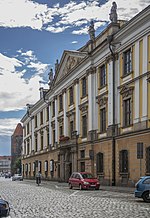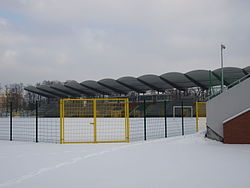Cathedral of Saint Apostles Peter and Paul in Legnica
Buildings and structures in LegnicaBurial sites of the Piast dynastyChurches in Lower Silesian VoivodeshipRoman Catholic cathedrals in Poland

The Cathedral of Saint Apostles Peter and Paul in Legnica is located at Cathedral Square in the city of Legnica, Poland. The present building was erected between 1333 and 1380. A chapel was added in the fifteenth century, and in the late nineteenth century the church was converted into the neo-Gothic style. Over the centuries the church has acquired numerous statues and decorative features. Pope John Paul II established the church as a cathedral on March 25, 1992 and visited the cathedral on June 2, 1997.
Excerpt from the Wikipedia article Cathedral of Saint Apostles Peter and Paul in Legnica (License: CC BY-SA 3.0, Authors, Images).Cathedral of Saint Apostles Peter and Paul in Legnica
Plac Katedralny, Legnica
Geographical coordinates (GPS) Address Website External links Nearby Places Show on map
Geographical coordinates (GPS)
| Latitude | Longitude |
|---|---|
| N 51.206944444444 ° | E 16.161666666667 ° |
Address
Katedra pw. Świętych Apostołów Piotra i Pawła
Plac Katedralny 7
59-220 Legnica
Lower Silesian Voivodeship, Poland
Open on Google Maps











